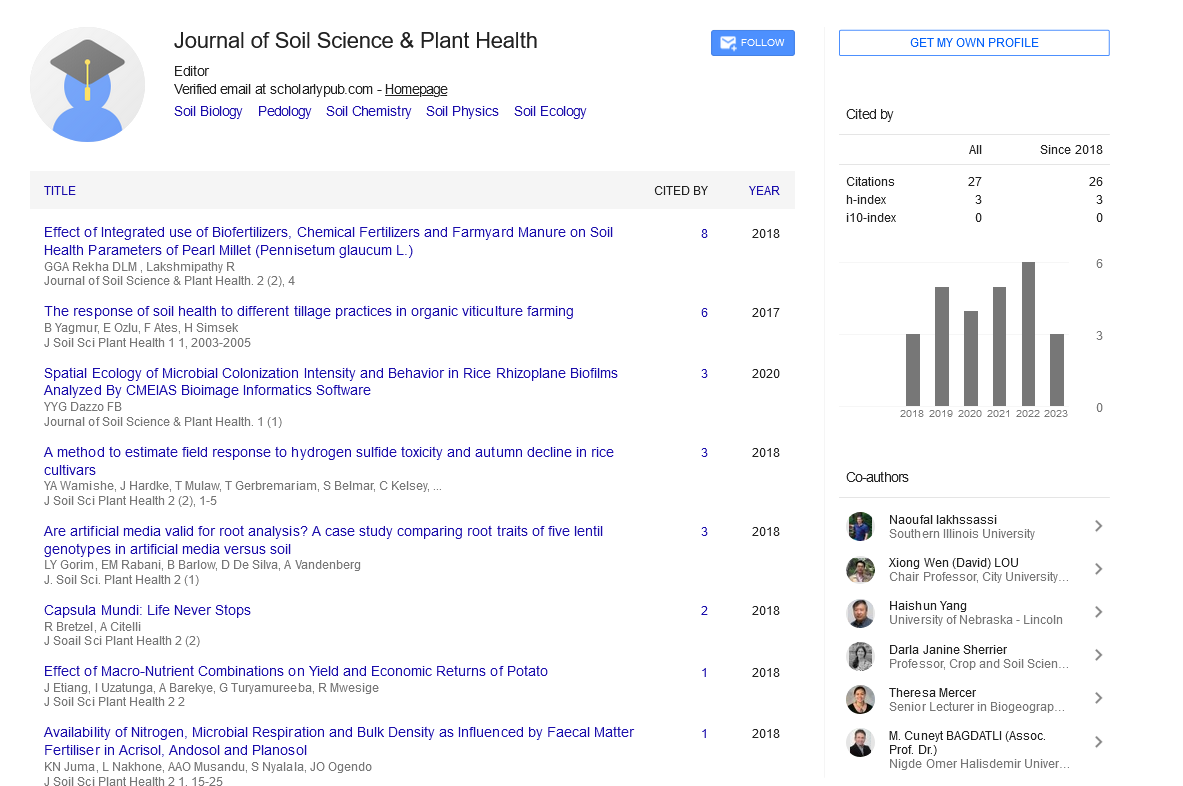Editorial, J Soil Sci Plant Health Vol: 7 Issue: 1
PFAS Remediation: Addressing the “Forever Chemicals†Crisis
Rani Prabhu*
Department of Crop Science and Horticulture, Indian Statistical Institute, India
- *Corresponding Author:
- Rani Prabhu
Department of Crop Science and Horticulture, Indian Statistical Institute, India
E-mail: rani645@gmail.com
Received: 01-Feb-2025, Manuscript No. Jsph-25-170162; Editor assigned: 4-Feb-2025, Pre-QC No. Jsph-25-170162 (PQ); Reviewed: 18-Feb-2025, QC No. Jsph-25-170162; Revised: 25-Feb-2025, Manuscript No. Jsph-25- 170162 (R); Published: 28-Feb-2025, DOI: 10.4172/jsph.1000207
Citation: Rani P (2025) PFAS Remediation: Addressing the â??Forever Chemicalsâ? Crisis. J Soil Sci Plant Health 7: 207
Introduction
Per- and polyfluoroalkyl substances (PFAS) are a group of man-made chemicals widely used in consumer products and industrial applications since the 1940s. Known for their resistance to heat, water, and oil, PFAS are found in firefighting foams, non-stick cookware, waterproof clothing, and food packaging. However, their chemical stability has led to them being dubbed “forever chemicals,” as they persist in the environment and human body for decades. Studies link PFAS exposure to serious health issues including cancer, liver damage, immune system disruption, and developmental problems [1]. As contamination spreads globally, especially in soil and water sources, effective PFAS remediation has become an urgent environmental and public health priority [2].
Discussion
PFAS contamination is particularly challenging due to the strength of the carbon-fluorine bond, one of the strongest in organic chemistry. Traditional water treatment methods like activated carbon or standard filtration are often ineffective for many PFAS compounds, especially short-chain variants. Remediation efforts must therefore employ innovative and often combined approaches [3].
Adsorption Technologies: Granular activated carbon (GAC) and ion exchange resins are among the most widely used technologies. GAC is effective for long-chain PFAS, while ion exchange resins can target a broader spectrum of PFAS, including some short-chain types. However, these methods capture but do not destroy the chemicals, creating challenges for safe disposal.
Advanced Oxidation and Reduction: Techniques such as electrochemical oxidation, plasma treatment, and photocatalysis aim to break down PFAS molecules. While promising in lab settings, scalability and high energy costs remain barriers for large-scale deployment [4].
Thermal Destruction: Incineration at extremely high temperatures can destroy PFAS, but concerns over incomplete combustion and atmospheric release of byproducts have raised regulatory scrutiny. Research into safer thermal treatments, such as supercritical water oxidation, is ongoing [5].
In-situ Remediation: For soil and groundwater, emerging strategies include injecting reactive materials like colloidal activated carbon to immobilize PFAS or applying bioremediation methods, although no known microbes can yet fully degrade PFAS. These methods are still largely experimental.
Emerging Approaches: Novel technologies, including enzyme-based treatments and nanomaterials, show potential to enhance PFAS degradation. Additionally, some academic and government-funded research is focusing on PFAS destruction at the molecular level using defluorinating agents.
While progress is being made, no single “silver bullet” exists. Successful remediation often requires integrating multiple technologies tailored to specific site conditions, PFAS types, and regulatory limits.
Conclusion
PFAS contamination represents a complex, persistent threat to ecosystems and public health. As awareness and regulations increase, so does the demand for effective and sustainable remediation technologies. Current solutions offer partial success, but they often shift the problem elsewhere or are economically or logistically limiting. A coordinated global effort in research, innovation, and policy enforcement is essential to develop scalable, efficient, and safe PFAS destruction methods. The path forward must balance technological advancement with environmental stewardship to ensure a cleaner and safer future.
References
- Park C (2013). Mind-body CAM interventions: Current status and considerations for integration into clinical health psychology. J Clin Psychol. 69: 45-63.
- Sarris J, Glick R, Hoenders R, Duffy J, Lake J, et al (2014). Integrative mental healthcare White paper: establishing a new paradigm through research, education, and clinical guidelines. Adv Int Med. 1: 9-16.
- Beagan Brenda (2003). Teaching Social and Cultural Awareness to Medical Students: â??Itâ??s All Very Nice to Talk about It in Theory, but Ultimately It Makes No Difference. Academic Medicine. 78: 605-14.
- Grace S, Higgs J (2010). Integrative medicine: enhancing quality in primary health care. J Altern Complement Med. 16: 945â??950.
- Templeman K, Robinson A (2011). Integrative medicine models in contemporary primary health care. Complement Ther Med. 19: 84-92.
Indexed at, Google scholar, Cross ref
Indexed at, Google scholar, Cross ref
Indexed at, Google scholar, Cross ref
Indexed at, Google scholar, Cross ref
 Spanish
Spanish  Chinese
Chinese  Russian
Russian  German
German  French
French  Japanese
Japanese  Portuguese
Portuguese  Hindi
Hindi 